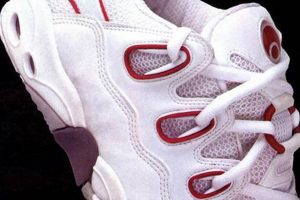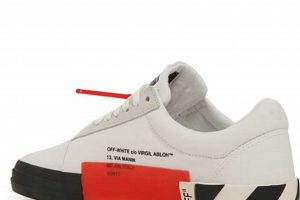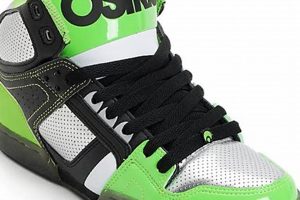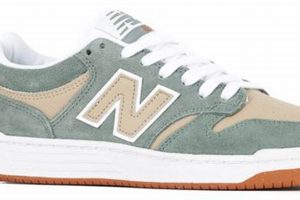The method of fastening footwear on skate shoes, specifically using laces, involves techniques that provide a secure and comfortable fit. A typical instance includes threading the laces through the eyelets of the shoe and employing a knot to maintain tension and prevent slippage.
Properly secured footwear contributes significantly to skater safety and performance. Adequately tightened laces enhance board control, prevent ankle instability, and minimize the risk of injuries during maneuvers. Historically, variations in lacing techniques have emerged, reflecting evolving preferences for fit, aesthetics, and durability in the skateboarding community.
The subsequent sections will explore specific lacing techniques applicable to skate shoes, detailing steps for achieving optimal fit and addressing considerations for lace durability and style preferences.
Lacing Techniques for Skate Shoes
Effective lacing of skate shoes requires attention to detail, impacting both performance and longevity of the footwear.
Tip 1: Lace Material Selection: Opt for durable laces constructed from materials such as nylon or reinforced fibers. These materials resist abrasion from griptape and provide enhanced longevity.
Tip 2: Consistent Tension Distribution: When threading laces, ensure uniform tension across all eyelets. Uneven tension can lead to pressure points and discomfort during skating.
Tip 3: Knot Security: Employ a secure knot, such as a square knot or surgeon’s knot, to prevent laces from loosening during activity. Periodically inspect the knot for wear or fraying.
Tip 4: Avoid Over-Tightening: Excessive tightening of laces can restrict blood flow and cause discomfort. The fit should be snug but allow for natural foot movement.
Tip 5: Consider Lace Length: Choose a lace length appropriate for the shoe and desired lacing pattern. Excessively long laces pose a tripping hazard, while laces that are too short may be difficult to secure.
Tip 6: Address Lace Bite: “Lace bite,” pressure from the tongue pressing on the ankle, can be mitigated by using padded tongues or exploring alternative lacing patterns that distribute pressure more evenly.
Proper execution of these lacing considerations enhances both the functional performance and lifespan of skate shoes.
The following section will provide information on common lacing patterns and their suitability for various skating styles.
1. Tightness
Tightness, as it relates to skate shoe lacing, directly influences board feel, stability, and overall control. Insufficient tightness allows the foot to move within the shoe, diminishing board sensitivity and potentially causing instability during maneuvers. Conversely, excessive tightness restricts circulation, leading to discomfort and reduced foot mobility. The ideal tightness achieves a balance, providing a secure fit without compromising comfort or natural foot articulation. For example, a skater performing flip tricks requires a snug fit to maintain board control; however, prolonged skating with overly tight laces can lead to foot fatigue and cramping.
The degree of tightness can be customized based on individual preferences and the specific type of skating. Street skaters often prefer a tighter fit for enhanced board feel during technical tricks, while transition skaters might opt for slightly looser lacing to allow for greater ankle flexibility. The choice of lacing pattern can also impact tightness distribution. For instance, a straight-bar lacing pattern may provide a more uniform tightness compared to a criss-cross pattern. Furthermore, the material and construction of the laces themselves influence how effectively tightness is maintained over time. Stretchy or worn laces are prone to loosening, necessitating more frequent adjustments.
In summary, optimal tightness in skate shoe lacing is critical for maximizing performance and minimizing discomfort or injury. Attaining the appropriate balance requires consideration of individual foot anatomy, skating style, lacing pattern, and lace material. Addressing tightness proactively ensures a secure and responsive connection between skater and board, facilitating progression and preventing potential issues. This element is non-negotiable for success.
2. Durability
The durability of laces is intrinsically linked to the effectiveness of fastening skate shoes. A fundamental aspect of skateboarding is the repetitive abrasion the shoe experiences against the griptape of the board. Standard laces are susceptible to rapid degradation under these conditions, resulting in breakage and the subsequent necessity for frequent replacements. Compromised lace integrity directly affects the ability to securely fasten the skate shoe, impairing board control and elevating the risk of injury. The choice of lace material and lacing technique significantly influences overall longevity. For example, laces constructed from reinforced nylon or Kevlar-blended fibers offer increased resistance to abrasion compared to conventional cotton laces. The implementation of lacing patterns that minimize direct contact between the lace and griptape, such as hidden lace techniques, can further enhance durability.
The impact of skate shoe lace durability extends beyond mere cost considerations. Frequent lace failures disrupt skating sessions, diverting attention from the activity and potentially hindering skill development. Furthermore, repeatedly replacing laces contributes to increased waste. From a performance standpoint, laces that stretch or fray easily compromise the consistency of the shoe’s fit, impacting responsiveness and control. A skater attempting a technical maneuver, for instance, requires a predictable and secure fit; compromised laces undermine this stability, potentially leading to failed attempts and increased risk of falls. Thus, prioritizing lace durability translates to improved skating performance and reduced maintenance demands.
In summary, durability constitutes a critical factor in the overall performance and longevity of skate shoe lacing systems. Selection of appropriate materials, coupled with strategic lacing techniques, mitigates the detrimental effects of abrasion and wear. Addressing durability proactively enhances skater safety, improves board control, and minimizes disruptions caused by frequent lace failures. The practical significance of this understanding underscores the importance of considering lace durability as an integral component of skate shoe maintenance and performance optimization.
3. Comfort
Comfort, in the context of securing skate shoes, extends beyond mere absence of discomfort. It encompasses a range of factors that, when optimized, enhance performance and prevent injuries.
- Pressure Distribution
Uniform distribution of pressure is critical. Improper lacing can concentrate pressure on specific areas of the foot, leading to discomfort, blisters, or even restricted blood flow. For example, overtightening laces across the instep can compress nerves and tendons, causing pain and limiting mobility. Lacing techniques that distribute pressure evenly, such as skipping eyelets or utilizing wider laces, mitigate these issues.
- Ankle Support vs. Flexibility
Balancing ankle support with the necessary flexibility for skateboarding maneuvers is crucial for comfort. Overly tight lacing around the ankle can restrict movement, hindering trick execution and increasing fatigue. Conversely, insufficient support can lead to ankle instability and a higher risk of sprains. Skaters often adjust lacing patterns to achieve the optimal balance, tightening laces around the lower ankle for support while leaving the upper eyelets looser for greater flexibility.
- Lace Material and Texture
The material and texture of the laces themselves contribute significantly to comfort. Rough or inflexible laces can cause friction against the tongue of the shoe, leading to irritation and discomfort. Softer, more pliable laces, particularly those made from materials like nylon or polyester, minimize friction and conform better to the shape of the foot. Furthermore, flat laces tend to distribute pressure more evenly than round laces, enhancing overall comfort.
- Toe Box Space and Lacing
The way laces are tied can indirectly influence toe box space and comfort. Lacing patterns that pull the sides of the shoe inward excessively can compress the toes, leading to discomfort and potential long-term issues like bunions. Looser lacing in the lower eyelets allows for greater toe splay and reduces the risk of compression. Skaters with wider feet may benefit from utilizing lacing techniques that maximize toe box space.
These facets collectively illustrate that optimizing for comfort when securing skate shoes is not merely a matter of avoiding pain. Rather, it involves a nuanced understanding of pressure distribution, ankle support, lace material, and their impact on foot mechanics. Addressing these factors contributes to enhanced performance, injury prevention, and overall enjoyment of the activity.
4. Knot security
Knot security, in the context of securing skate shoes, represents a critical factor directly influencing both safety and performance. The primary function of properly secured laces is to maintain a consistent and reliable fit. A compromised knot, susceptible to loosening during activity, introduces instability, increasing the risk of ankle injury and diminished board control. For instance, if laces loosen during a complex trick execution, the skater’s foot may shift within the shoe, leading to a loss of balance and a potential fall. The selection of an appropriate knot and the method of tightening significantly impact the likelihood of slippage or premature failure. A poorly executed knot inherently undermines the purpose of lacing, regardless of the quality of the shoe or the material of the laces.
The ramifications of inadequate knot security extend beyond the immediate physical risks. Constant adjustments to loosened laces disrupt the flow of skating, diverting concentration and hindering the development of consistent technique. For example, a skater repeatedly stopping to retie laces during a practice session loses valuable time and momentum, potentially affecting their ability to master a new skill. Furthermore, repetitive tightening of compromised knots accelerates wear and tear on the laces, ultimately leading to premature breakage. Practical applications of improved knotting techniques involve utilizing knots specifically designed for high-stress environments, such as the surgeon’s knot or variations of the square knot, and ensuring that the knot is consistently tightened and dressed correctly to minimize slippage.
In summary, knot security forms an indispensable component of effective skate shoe lacing. Its absence creates a cascade of potential issues, ranging from increased risk of injury to diminished performance and accelerated wear on equipment. Addressing knot security through the selection of appropriate knots and rigorous tightening procedures contributes significantly to skater safety, performance consistency, and the overall longevity of skate shoes. The understanding and application of secure knotting practices represent a fundamental skill for any skater seeking to maximize both safety and performance.
5. Ankle support
Ankle support, as achieved through specific lacing techniques on skate shoes, directly influences stability and injury prevention. The configuration of laces around the ankle joint dictates the degree of restriction or freedom of movement. Tighter lacing in the upper eyelets provides increased support, limiting excessive inversion or eversion, common mechanisms of ankle sprains. Conversely, looser lacing allows for greater range of motion, which may be preferred by skaters prioritizing flexibility for certain maneuvers. The cause-and-effect relationship is evident: increased tension in the laces around the ankle results in a greater degree of support, while reduced tension offers less protection against lateral movements. Ankle support is a critical component of proper skate shoe lacing, as it mitigates the risk of injuries associated with the high-impact and often unpredictable nature of skateboarding. For example, a skater landing awkwardly after a jump relies on the support provided by the laces to prevent the ankle from rolling.
Lacing patterns can be strategically employed to address individual needs for ankle support. Skaters with a history of ankle instability may benefit from utilizing lacing techniques that reinforce the ankle joint, such as a “heel lock” or “lace lock” method. These techniques effectively anchor the heel within the shoe, minimizing movement and enhancing stability. Conversely, skaters performing technical flat ground tricks may prefer a looser lacing configuration to allow for greater ankle flexibility. The practical application involves experimenting with different lacing patterns to determine the optimal balance between support and range of motion, based on individual anatomy, skating style, and injury history. Furthermore, the type of skate shoe itself influences the level of ankle support attainable through lacing. High-top skate shoes inherently offer more ankle support than low-top models, regardless of lacing technique.
In summary, the degree of ankle support provided through skate shoe lacing is a crucial determinant of skater safety and performance. The challenge lies in finding the optimal balance between support and flexibility, which requires consideration of individual needs and preferences. By understanding the direct correlation between lacing techniques and ankle stability, skaters can make informed decisions to minimize the risk of injury and enhance their overall skating experience. The practical significance of this understanding underscores the importance of experimentation and adjustment to achieve the desired level of support without compromising mobility.
6. Lace length
The correlation between lace length and effective skate shoe fastening is direct and consequential. Inadequate lace length precludes proper knot tying, compromising security and support. Conversely, excessive length presents a tripping hazard and detracts from functionality. The selection of appropriate lace length is therefore integral to achieving a secure and comfortable fit. For example, a lace that is too short may not allow for a secure knot to be tied, resulting in the shoe loosening during skating. A lace that is too long will require excessive looping or tucking, potentially interfering with board feel and creating a safety risk.
Practical implications of incorrect lace length are multifaceted. Difficulty in achieving a secure knot leads to frequent adjustments during skating, disrupting focus and potentially affecting performance. Excessive lace length not only poses a tripping hazard but also increases wear and tear as the lace drags against the ground or griptape. Skaters address these issues through measurement or trial and error when selecting replacement laces. Additionally, varying lacing patterns (e.g., criss-cross, straight-bar) affect the required lace length. Straight-bar lacing, for instance, typically necessitates longer laces compared to criss-cross patterns, due to the increased length of lace required to span horizontally between eyelets.
In summary, appropriate lace length is a crucial, yet often overlooked, component of effective skate shoe lacing. It directly impacts knot security, safety, and overall functionality. Careful consideration of lace length, in conjunction with desired lacing patterns, enables skaters to achieve a secure and comfortable fit, minimizing distractions and maximizing performance. Addressing lace length proactively, rather than as an afterthought, contributes significantly to the overall skating experience.
7. Lacing style
Lacing style, in the context of skate footwear, significantly impacts shoe fit, performance, and aesthetic presentation. The selection and execution of a particular lacing style determine comfort, support, and the shoe’s ability to withstand the rigors of skateboarding.
- Criss-Cross Lacing
Criss-cross lacing, a common method, involves alternating the laces across the shoe’s eyelets. This technique distributes tension relatively evenly, offering a secure fit suitable for general skating. However, it may be prone to abrasion on the laces themselves, as they are exposed to the griptape more directly. An example is a skater utilizing this method for basic street skating, finding adequate support but potentially noticing lace wear over time.
- Straight-Bar Lacing (European Style)
Straight-bar lacing, characterized by horizontal lace segments between eyelets, presents a cleaner aesthetic and can reduce pressure points on the top of the foot. This style often requires longer laces. It may not provide the same level of secure fit as criss-cross lacing for aggressive skating, but finds favor among those prioritizing comfort and a minimalist appearance. A skater might employ this technique for casual cruising or filming, where aesthetics take precedence over maximum support.
- Hidden Laces/Lace Protection
Lacing styles that conceal the laces, or incorporate lace protection, aim to minimize abrasion from the griptape, thereby extending lace lifespan. This can involve threading the laces through hidden channels or utilizing lace protectors. While these techniques enhance durability, they may also complicate the lacing process and potentially alter the shoe’s fit. A skater focused on performing ollies and flip tricks might choose this style to prevent frequent lace breakage.
- Heel-Lock Lacing
Heel-lock lacing focuses on securing the heel within the shoe to prevent slippage and enhance ankle stability. This involves creating a loop with the laces at the top eyelets and threading the ends through the opposite loops before tying. This method is particularly beneficial for skaters with narrow heels or those seeking increased ankle support. A skater recovering from an ankle injury, or one performing demanding transition skating, could utilize this technique for added stability.
Each of these lacing styles offers distinct advantages and disadvantages, influencing the way the shoe fits, performs, and withstands the stresses of skateboarding. The appropriate selection depends on individual preferences, skating style, and the desired balance between comfort, support, and durability. Understanding these nuances is vital for optimizing the interaction between skater and footwear.
Frequently Asked Questions
The following addresses common inquiries regarding proper lacing techniques for skate shoes, emphasizing performance, safety, and durability.
Question 1: Why is proper skate shoe lacing important?
Secure lacing provides optimal board feel, prevents ankle instability, and minimizes the risk of injury. Consistent fit enables predictable performance.
Question 2: How often should skate shoe laces be replaced?
Replacement frequency depends on skating intensity and lace material. Inspect laces regularly for fraying or wear; replace when integrity is compromised.
Question 3: What type of knot is most secure for skate shoe laces?
A square knot or surgeon’s knot, properly tightened, offers enhanced security compared to simpler knots. Ensure the knot is dressed correctly to prevent slippage.
Question 4: Is it necessary to lace skate shoes tightly?
Tightness should provide a secure fit without restricting blood flow or foot movement. Excessive tightness leads to discomfort and potential injury.
Question 5: How can lace bite be prevented?
Lace bite, pressure on the ankle from the tongue, is mitigated by padded tongues, alternative lacing patterns, or skipping eyelets to redistribute pressure.
Question 6: Does lacing style affect skate shoe performance?
Yes, lacing style influences support, comfort, and durability. Experiment with different patterns to find the optimal balance for individual skating preferences.
In conclusion, attention to lacing technique and lace maintenance directly impacts skater safety, performance, and the longevity of skate footwear. Proactive adjustments ensure consistent and reliable performance.
The subsequent section provides a step-by-step guide to common lacing patterns for skate shoes, providing visual aids and practical tips.
Securing Performance
This exposition has elucidated the fundamental principles governing effective skate shoe lacing. From considerations of tightness and durability to the selection of appropriate lacing styles and knotting techniques, the interconnectedness of these factors underscores their collective impact on skater safety and performance. Understanding these principles empowers skaters to optimize their footwear for enhanced control, stability, and longevity.
The act of fastening skate shoes transcends mere functionality; it constitutes an essential step in preparing for the demands of skateboarding. Mastery of this skill, coupled with diligent lace maintenance, contributes directly to a safer and more rewarding skating experience. Prioritizing attention to detail ensures that footwear serves as a reliable foundation for progression and skill development.







